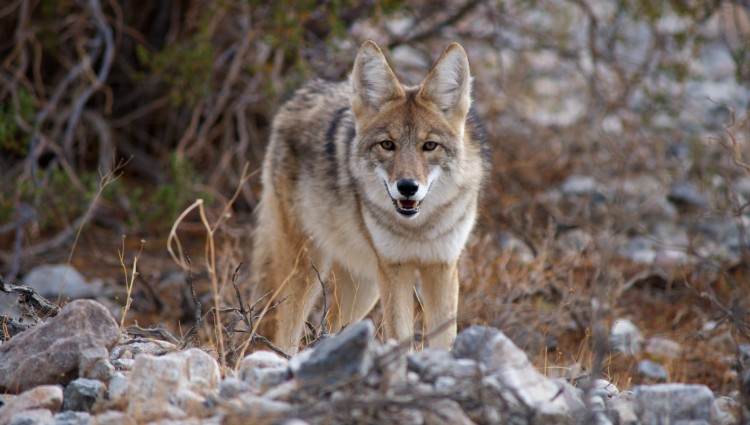
Wildlife officials are renewing their warnings about the dangers of feeding wild animals after a spate of recent incidents involving predators that have lost their fear of humans.
In late January, a state game warden in Pahrump was forced to kill an adult mountain lion so comfortable around people that she made her den behind a house not far from the town’s busiest shopping center.
Now a group of residents in Blue Diamond plans to hire private trappers to dispose of problem coyotes in their small village at the edge of Red Rock Canyon, where the animals have been baited with food and are snapping up family pets.
Doug Nielsen, spokesman for the Nevada Department of Wildlife, said such trouble can almost always be traced to humans, and it rarely ends well for the wildlife involved.
“These animals usually don’t want to have anything to do with us. When they do become habituated to us, it’s our fault,” he said.
Most of the time, the feeding of wildlife is unintentional. People leave bowls of food out in the backyard for their pets, fail to secure their garbage or let fruit rot on the ground when it falls from their trees.
But in some cases, wild animals are being lured into neighborhoods on purpose by people who like having wildlife around and think Mother Nature needs a helping hand.
Nielsen said the mountain lion shot and killed in Pahrump on Jan. 25 was a roughly 65-pound adult female that had taken up residence in a thicket behind a house just west of the town’s Wal-Mart store. Authorities found food bowls and other items around the den, suggesting the animal had a human benefactor.
“That lion was very comfortable,” Nielsen said. “It wasn’t leaving, and that’s very unusual behavior for a mountain lion.”
Game wardens don’t enjoy killing animals like that, he said, but it’s difficult and dangerous to try to capture and relocate a predator once it loses its fear of people. “When it comes down to a public safety issue, you really don’t have a choice.”
The state doesn’t relocate coyotes either, Nielsen said. They are considered “rabies vectors,” so nuisance animals are generally killed on the spot as humanely as possible.
In November, the Department of Wildlife began mapping the predator calls it receives so it can tailor its response to specific areas. Nielsen said sightings are most common in rural communities and neighborhoods at the fringes of the Las Vegas Valley, and along open-space corridors that connect to the desert.
Over the next month, state wildlife officials plan to host neighborhood meetings on the issue in Anthem, Rhodes Ranch and the neighborhood next to Sunset Park. Last week, a game warden met to discuss coyote issues with residents in Blue Diamond.
Trouble is also brewing at Lake Mead National Recreation Area, where officials are drafting a “coyote action plan” in response to a rise in animal sightings at campgrounds, marinas and along roads in the park.
Lake Mead spokeswoman Christie Vanover said the plan will be heavy on education since the real problem is people. Last month, rangers issued a citation to a motorist who was observed feeding a coyote out the window of a car, she said.
The problem is personal for Blue Diamond resident Judy Brandt and her partner. Last month, their 15-year-old cat, Buster, was snatched from their porch by a pair of coyotes. The women rushed out just in time to snatch the cat away from the animals, but he died in their arms.
Brandt said the coyotes didn’t run away at first, even as the women hollered and moved toward them.
Brandt has lived in Blue Diamond for 14 years, and she said she’s never seen so many coyotes walking around like they own the place. They are a common sight in people’s driveways and backyards — day or night — and they don’t react to people the way they used to.
“It used to be that when you walked toward a coyote they would run away. Now they just stand there or they run away and then stop and look back at you,” she said. “What’s too close has changed, too. They’re not afraid. They’re just not afraid.”
State law prohibits intentionally feeding coyotes and similar wildlife, but the crime is hard to prove and rarely prosecuted.
“The tough thing with making cases like that is you have show intent,” said Nielsen, who also writes an outdoors column for the Las Vegas Review-Journal.
Brandt blames the problem in Blue Diamond on a “very, very small minority” of residents.
“Most people know better than to feed coyotes and burros,” she said.
Now it’s the animals that will pay the price, as they so often do.
Brandt said she and some of her neighbors are chipping in to hire one of two trapping companies licensed by the state to kill coyotes. She said she knows some people will be angry about that, but something has to be done.
Nielsen doesn’t blame her for feeling that way, but he said any improvements could be temporary.
“If the human behavior doesn’t change, the problem is just going to recreate itself,” the wildlife spokesman said. “Really the common denominator is always us.”
